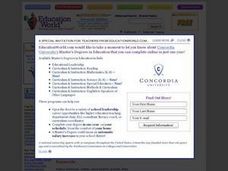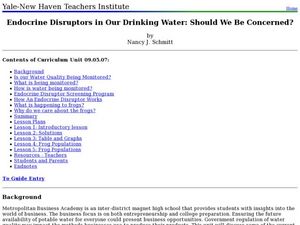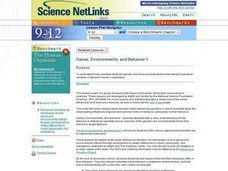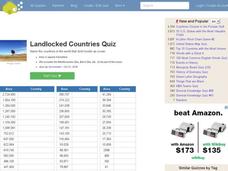Curated OER
Eyes Worldwide on the Prize
Students examine Martin Luther King, Jr.'s "I Have a Dream" speech and see how it has been produced in China by reading an online article. They study discrimination in the world and write responses to the speech.
Curated OER
Species on the Edge
Students describe factors negatively affecting population of sea turtles, and identify and discuss action that can be undertaken to reduce or eliminate threats to sea turtles and other endangered species.
Curated OER
Native American Word Search
Students search this puzzle for the names of 20 of the most populous Native American groups in the United States today. They find in this word search puzzle the names of 20 of the 30 most populous Indian groups, according to the 1990...
Curated OER
Australia and Argentina: A Study in Contrast
Students study world events and their effect on economic growth. They research and interpret graphs to determine explanations for economic growth. Students compare the World Wars and the Great Depression to the growth of Argentina and...
Curated OER
Forest Loss Slows as Asian Nations Plant
Students survey the loss of forests around the world. In this environmental lesson, students read an article that outlines how forests are being lost and government interaction which encourages forests to be rebuilt. Activities to...
Curated OER
Rising Temperatures Threaten Penguins
Students examine the continent of Antarctica, then read a news article about the decline in the Antarctic penguin population. For this current events lesson, the teacher introduces the article with a discussion and vocabulary activity,...
Curated OER
Site and Situation: Right Place at the Right Time
Students put their geography skills to work. For this geography skills lesson, students research maps and other primary and secondary sources to simulate the site selection process for the Pennsylvania Railroad Shops post World War II....
Curated OER
The Race
Students play game simulating route turtle hatchlings take from clutch to ocean, and describe threats hatchlings face and how this affects the marine turtle population.
Curated OER
Border to Border
Students use the Internet to gather information on the country of Mexico. They also discover the culture of their people and compare them with the United States population. They take a virtual tour of some of Mexico's most historical ruins.
Curated OER
The Black Plague: International Insects
Sixth graders research conditions that caused 16th Century Black Plague and led to downfall of Europe, and examine causes and effects of population density, disease, and invention.
Curated OER
Changes in the New Nation
Students explore how technology has slowly changed the world, starting in the 18th Century. In this United States History lesson, students work in teams to complete numerous activities that compare and contrast life before and after...
Curated OER
Endocrine Disruptors in Our Drinking Water: Should We Be Concerned?
Young scholars investigate the different hormone contaminants in the water supply. In this math lesson, students analyze data tables and graphs. They demonstrate exponential growth and decay using frog populations.
Curated OER
Coral Reef Conservation
Students conduct discussions on current threats to coral reefs around the world and write letters to conservation organizations urging support for coral reef protection.
Curated OER
Sharia
Students examine the story of a woman convicted of adultery and sentenced to death. They identify terms associated with Islamic law and beliefs. They compare and contrast this case with the American legal system.
Curated OER
Does One Tree a Forest Make?
Students take a walk around the schoolyard looking at and identifying the trees. One leaf for each tree is collected. A chart is developed that represents the population of trees on the school ground. They keep journals and write an essay.
Curated OER
WHALES: GIANTS OF THE DEEP
Young scholars study humpback whale migrations, feeding, social organization, population, scientific investigations and compare humpback whales , research to explore a specific type of whale, and create their own replica of a whale.
Curated OER
Genes, Environments, and Behavior 1
Students examine how scientists study the genetic and environmental factors that interact to produce variation in behavior across a population.
Curated OER
O Canada
Learners examine the history of Canadian settlement through an interactive program. They learn why some parts of the country where more heavily populated than others. They discover what life is like for a Canadian and their government...
Curated OER
Tracking Narwhals in Greenland The Ocean Unicorn
Students study the ecology, habitats, geographic range and feeding habits of narwhals. They determine at least three reasons for the decline in the narwhal populations and complete the accompanying worksheets.
Curated OER
Fish and Flowers
Students read and discuss a research article that explains the unlikely link between increased fish populations and increased plant pollination. They answer reading guide questions to discover this ecological relationship.
Curated OER
Turtle Lesson
Young scholars identify ways that they can help protect turtles. In this wildlife awareness lesson, students read the story Turtle World and construct a T-chart on the board. Young scholars create a list of problems facing turtles and...
Curated OER
Are All Children at the Same Starting Gate?
Students examine the education experience around the world. In this global studies lesson, students research education standards and practices in developing and developed nations. Students share their research findings in a class project...
Curated OER
Australia
Students enhance their knowledge about the history of Australia. In this World History lesson, students engage in a teacher-led classroom discussion about Australia's history, then write a journal depicting the events that stood out to...
Curated OER
Landlocked Countries Quiz
In this online interactive geography quiz worksheet, students examine the chart that includes details about the population in 44 landlocked countries. Students identify the names of the countries in 5 minutes.

























